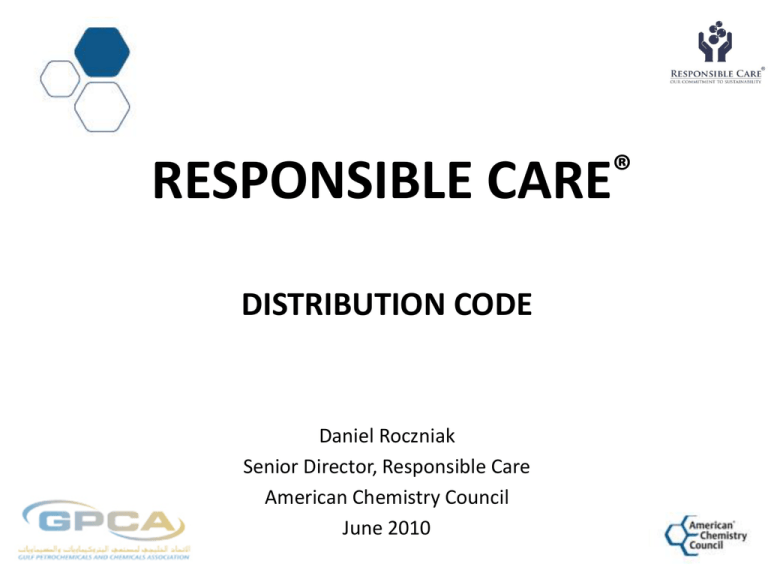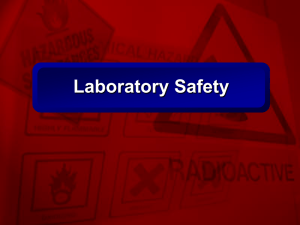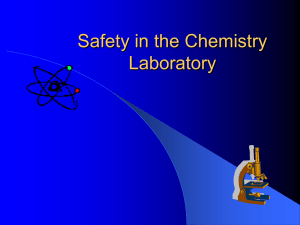Responsible CarE® Distribution Code
advertisement

RESPONSIBLE ® CARE DISTRIBUTION CODE Daniel Roczniak Senior Director, Responsible Care American Chemistry Council June 2010 Distribution Code Presentation Topics • Background – Why a Distribution Code? – Public concerns addressed by the code. • Key Focus areas of the Code • Link to other Codes • Benefits of implementing the Distribution Code • Questions and Answers Distribution Code Why a Distribution Code? • Reduce the risk of harm posed by the distribution (transportation) of chemicals to the general public; to carriers, distributors, contractors and chemical industry employees; and to the environment. • Respond to public concerns about safety of products in transit. • Improve “hand-off” processes between producers, carriers, storage facilities and customers. • Movement of products = increased risk. Distribution Code Public Concerns Addressed • Reduce risks associated with chemical distribution. • Strengthen compliance and other training across the supply chain. • Process to qualify carriers, warehouses and bulk liquid storage facilities based on EHS criteria. • Ensure safe storage, loading and unloading of product; cleaning of containers/tanks and proper disposal of wastes. • Establishment of emergency response programs to address transportation accidents/incidents. Distribution Code Key Elements – Risk Management • Three elements focus on risk management. – Regular evaluation of chemical distribution risks: • • • • Hazards of the materials Likelihood of accidents/incidents Potential for human and environmental exposure Routing – Implementation of risk reduction measures – Internal reporting and investigation of distribution accidents/incidents and preventive measures. Distribution Code Key Elements – Compliance Review & Training • Four elements address compliance review and training: – Process to monitor and implement changes to existing regulations and standards or new regulations. – Training for employees in the proper implementation of regulations and company regulations. – Process for providing guidance and information to carriers, distributors and contractors who perform distribution activities. – Regular review of employee and commercial partner compliance with regulations and company requirements. Distribution Code Key Elements – Carrier Safety • Two elements address carrier safety: – Process for qualifying Carriers of all modes and types that transport chemicals to and from the company that emphasizes: • Safety fitness • Regulatory Compliance and includes regular reviews of performance and compliance. – Process to provide feedback to carriers on their performance and suggestions for improvement. Distribution Code Key Elements – Handling and Storage • Seven elements address Handling and Storage – – – – Procedures for selection and use of containers Procedures for loading chemicals safely at facilities Procedures for unloading chemicals safely at facilities Criteria for cleaning and returning tank cars and other containers and for disposal of residue – Provide guidance to customers and others on loading and unloading and storing of product. – Process for selecting distributors and storage facilities that handle product in transit. – Provide feedback to distributors and other facilities that handle product in transit. Distribution Code Key Elements – Emergency Preparedness • Five elements focus on Emergency Preparedness – Process for responding to chemical distribution accidents involving the company’s products. – Procedures to make information about company products available to emergency responders along transport routes – Program to make facilities and training available to emergency response agencies – Dialogue with government agencies on the distribution and hazards of company chemicals – Dialogue with the public about chemical distribution issues Distribution Code Link to Other Codes Distribution Code CAER Code • Dialogue with public • Dialogue with ER agencies • Emergency Response plans Product Stewardship Process Safety •Facility Design Security • Security of product in transit • Dialogue with authorities • Safe transport considerations • Commercial partner handling of company products Distribution Code Benefits • Strengthened links between producers and their transport and storage providers. • Created common performance expectations across the supply chain. • Identified local concerns about transport of chemicals. • Created links between producers, transporters and emergency response agencies along transport routes. • Led to creation of ACC’s Responsible Care Partnership Program with more than 80 current participants. 12











